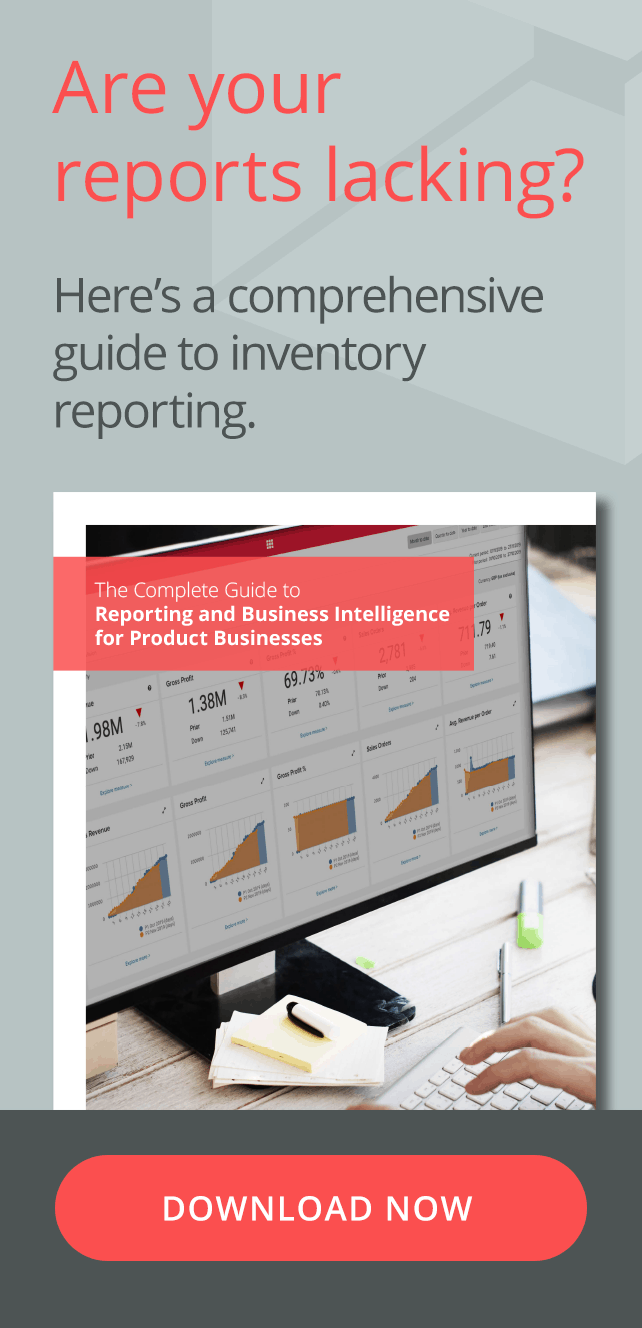In the ongoing battle to keep costs down while still meeting demand, inventory managers look for ways to figure out what their ideal order size is. How much should they purchase – and when – to manage costs without risking a stockout?
That’s where economic order quantity comes in. So what is the EOQ formula, and how do you use it? Let’s explore.
What is economic order quantity (EOQ)?
Economic order quantity (EOQ) is a formula that allows inventory managers to calculate their ideal order size. By comparing the cost of holding and selling goods with annual demand, businesses can determine the quantity they should order their materials in, and how frequently they should do this each year.
It’s an important figure for any business trying to minimise overspending while meeting demand, and especially for any business looking to reduce its overall inventory costs.
At the same time, EOQ has some key limitations that mean it’s not a formula every business can use – we lay out its advantages and disadvantages below.

The EOQ formula provides a way to calculate the ideal order size for your company – and in turn, the frequency with which you’ll place orders
What is the EOQ formula?
The EOQ formula is: EOQ = √(2DS/H)
In this formula:
- D = The number of units purchased of a particular product per year (annual demand)
- S = Order cost per purchase order
- H = Annual holding cost per unit
Another way express the economic order quantity formula is:
EOQ = The square root (√) of 2x (annual demand in units, multiplied by order cost per purchase order), divided by annual holding cost per unit.
How to calculate the components of the economic order quantity formula
1. Annual demand (D)
The number of units you sell each year. Note that we’re talking about actual sold units, not the value of said units.
2. Order cost per purchase order (S)
This is also known as a setup cost, and includes shipping and handling fees. Essentially, what does it cost your business to sell each individual unit?
3. Annual holding costs (H)
This is how much your business spends, per unit, per year, on carrying inventory. For that reason it’s also known as the carrying cost.
Here you’ll need another formula to work out what this the annual holding cost is per unit, which is:
Capital costs + inventory service costs + inventory risk costs + inventory storage costs, divided by average inventory value.
For this formula:
- Capital costs include the actual cost of your products/materials, as well as other factors such as interest and fees (e.g. loan maintenance fees).
- Inventory service costs are those related to holding products, such as IT hardware or software, tax and insurance premiums.
- Inventory storage costs refer to the costs associated with owning and operating a storage facility, including leasing costs as well as utilities and shipping.
- Finally, inventory risk costs include any that might reduce the value of your inventory, or its saleability, such as shrinkage, error, theft and loss of product value (i.e. reduced market demand, obsolescence).
Learn more: The 5 P’s of Inventory Shrinkage

Calculating EOQ requires clean data on your products – including annual demand and costs for your purchase orders, which are more accessible if you use an inventory management system
Calculating EOQ in practice: an example
James runs an eCommerce store that sells t-shirts, buying interesting designs in bulk and holding stock at a small warehouse.
He sells about 1,000 t-shirts per year, and calculates that his fixed order cost per purchase order is around $1.50. His holding cost per unit, per year is about $3.
So, putting that into a formula, our key figures are:
- Annual demand in units (D): 1,000
- Order cost per purchase order (S): $1.50
- Holding cost (H): $3
If we then put these figures into the economic order quantity formula, the equation you get is:
EOQ = √(2 x 1,000 x $1.50 / $3) = 31.6
If we round that up, we see that James’ ideal order size to minimise his costs while meeting customer demand is 32 t-shirts.
Assuming demand is constant throughout the year – which we’ll talk about more below – James will need to make this order about 31 times a year to meet his demand of selling 1,000 t-shirts. That means about one order of 32 t-shirts every 12 days.
Why is EOQ important for a product-based business?
EOQ is important because it’s one more tool in the inventory management toolbelt. Professionals around the world use this formula to try and figure out the sweet spot between buying enough products to meet demand (and leaving an extra buffer for fluctuating demand), and keeping costs as low as possible.
Techniques like the EOQ formula make it easier to figure out where that sweet spot lies. The idea is that you don’t end up with not enough stock on hand when a spike in demand hits – leading to stockouts and disappointed customers. You also avoid the opposite situation, where you overstock during a period of low demand, leading to potential spoilage or – at the very least – needlessly high holding costs.

Jack’s t-shirt business (discussed above) is an example of how to calculate EOQ – but one key limitation is that this calculation doesn’t take account of any steep fluctuations in demand throughout the year
What are the assumptions of the EOQ model?
EOQ can be a very useful formula, but it also has its limitations. The reason for this is that it makes assumptions about stock levels and demand throughout the year.
Generally speaking, EOQ assumes that all things remain constant all year. It doesn’t take account of the fact that there are variables that can fluctuate at different times of year, such as demand, costs, lead times, discounts and part shipments. And for businesses dealing with perishable products, it also doesn’t accommodate expiry dates.
With these limitations in mind, EOQ tends to work best with scale. The more purchase orders and units being shipped and the higher the costs, the more likely it is that these averages will be more representative of the year as a whole. When dealing with very small figures, EOQ may be too simplistic – useful more as an ‘average scenario’ indicator than a reliable figure.
Advantages of the EOQ model
Using the EOQ model brings has several advantages that will have an impact on business efficiency:
- Better order fulfilment: Using data to better guarantee you will have the right products on hand at the right time allows you to improve your order fulfilment, leading to increased sales – or rather, reducing the chance of lost sales due to stockouts.
- Less waste: Over-ordering, shrinkage, obsolescence – all of these can be reduced when you are better able to forecast demand.
- Improved storage cost efficiency: The above combine to improve the cost efficiency of your inventory storage, either because you have fewer products to store or less empty space on your shelves.
Disadvantages of the EOQ model
While the EOQ formula is a key inventory calculation, it’s important not to disregard its downsides:
- Known limitations: The limitations of using the EOQ model for small order quantities – as outlined above – mean it’s not right for every business. Getting around these limitations can make the formula more complex to calculate – but it is possible, especially with the right inventory management software doing the legwork.
- Requires clean data: In order to get accurate output, there must be accurate input. If you don’t have access to reliable data, or some of it is guesswork, the results of your EOQ calculation will be similarly unreliable.
- Inventory shortages: Some businesses find that when they start using EOQ for the first time they generate orders which are too small, leading to shortages. This is often a case of being too conservative with EOQ calculations. It can also be a problem when your business is growing quickly.

Using EOQ can mean better order fulfilment, since you’re more likely to have the products on hand when you need to ship them – but beware of being conservative with your calculations, which can lead to product shortages
Is economic order quantity the same as economic production order quantity (EPQ)?
Some sources will tell you that EOQ and EPQ are the same formula. But while they have some similarities, there is a key difference between them, and they’re meant to be calculated differently.
How are EOQ and EPQ similar?
Both EOQ and EPQ are a way of predicting inventory requirements to reduce costs and prevent stockouts. They even use a similar formula.
How are EOQ and EPQ different?
The key difference between EOQ and EPQ is captured in the names: ‘production’ versus ‘order’.
EOQ is based on ordering products from a third party, while EPQ refers to products being manufactured by the business, and therefore takes rate of production into account. Inventory managers use EPQ to determine optimum lot sizes during production in order to minimise equipment setup and product storage costs.

It’s easy to confuse EOQ with EPQ, but the key difference lies in the ‘P’ of the latter’s acronym, which stands for ‘production’
Economic order quantity vs. minimum order quantity (MOQ)
Minimum order quantity is not to be confused with EOQ. EOQ is a formula for calculating minimum purchase order requirements for a business, whereas MOQ is the minimum purchase order for the seller.
So a business would see it needs to reorder new materials soon based on its EOQ figure, but usually it’s not able to purchase less than the MOQ set by the company from which it makes that order. What this can mean is that the seller’s MOQ is higher than a buyer’s EOQ and the order can’t be placed.
EOQ in practice: How to use EOQ in Unleashed Software
Unleashed inventory software lets you set minimum and maximum stock levels for each product, and these will be based on your EOQ figure and ideal reorder point.
When your system notices that you’re close to your minimum stock level in Unleashed, it can automatically prompt you to reorder and pre-populate a purchase order with the correct quantity to take you back up to your maximum level.
Your EOQ figure is therefore a useful guide in setting minimum and maximum stock levels in Unleashed.
Sources used for this article:
Investopedia:
Marketing 91:
Assumptions of economic order quantity
Unleashed Software:
Your complete guide to average inventory
E Finance Management:
Economic order quantity and economic production quantity
MBASkool:





